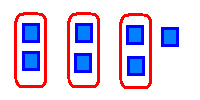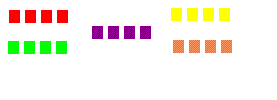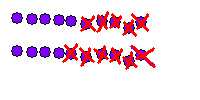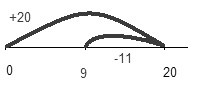Construction of Number Sentences: 2.5
Supporting materials
- Related Progression Points
- Developmental Overview of Structure (PDF - 35Kb)
- Developmental Overview of Numbers and Operations (PDF - 2.8Mb)
Indicator of Progress
Students can write and interpret number sentences to describe aspects of real world situations (e.g. a student writes 10 + 10 = 3 + 7 + 5 + 5 to describe a situation where 2 packets of 10 coloured pins contained 3 red, 7 green, 5 yellow and 5 white).
It is important that students learn to write number sentences because they display mathematical structure, and are the basis of algebraic equations. Constructing a number sentence from a real world situation is a critical step in using mathematics in everyday life.
Prior to this, students may write 'number sentences' by jotting down relevant numbers but not using appropriate operations to connect the numbers. Later, students will construct number sentences which describe real world situations of increasing complexity.
Illustration 1: Recording connections between numbers
A student working towards Level 1 who has 5 pencils and is given 3 more, may count that there are 8 pencils altogether and just write the three numbers 5, 3 and 8 across the page. The student has recorded the relevant numbers but no connection between them. When students first use a calculator, they will often use this approach of just recording the numbers (5, 3, 8), and not using the operations.
By Level 1.25 the student can describe the situation with the simple number sentence 5 + 3 = 8, which connects the numbers.
As students progress, they can write number sentences using more operations (addition, subtraction, multiplication and division) and can make more sophisticated combinations of operations.
Illustration 2: Using correct syntax
Writing correct number sentences requires that students use appropriate 'syntax'. This is like using correct grammar and punctuation in writing English. We have to do this so that the meaning is clear.
At Level 2.5 students appreciate that numbers are connected by operations and use '=' correctly to indicate both equivalence (3 × 4 = 12 and 12 = 3 × 4) and a result (e.g. 5 + 5 + 5 + 5 = 20). They can read number sentences out loud to make verbal sense (e.g. “three multiplied by four is equal to twelve”). Students may use brackets to indicate the order in which they wish operations to be carried out e.g. I have 3 packets of 4 pencils and 2 more pencils, so altogether I have 14 pencils: (3 × 4) + 2 = 14.
At this stage, it is not important to discuss whether the brackets are strictly necessary. Understanding when brackets are required to specify order of operations is assessed at Level 3.25.
For more information Order of Operations (Level 3.25) which addresses the need for students to recognise that the order in which operations are carried out can affect the answer.
Illustration 3: Describing situations mathematically
Being able to describe a real world situation with the correct mathematical operation(s) is an essential skill for using mathematics. For example, students should be able to write the number sentence 15 - 9 = 6 to describe both the following subtraction situations:
Matthew had 15 lollies and he ate 9. How many did he have left?
Matthew had 15 lollies. He dropped some and then had only 9 left. How many did he drop?
Illustration 4

Examples of the types of the tasks that would be illustrative of interpreting number sequences aligned from the Mathematics Online Interview:
- Question 27 - Teddies in cars
- Question 28 - Sharing teddies on the mat
- Question 29 - Tennis balls task
- Question 30 - Dot array task
- Question 31 - Teddies at the movies
Teaching Strategies
Constructing number sentences would be an everyday part of all number topics because it links mathematics with the real world. At every level students should construct number sentences associated with the topic being studied with gradually increasing complexity.
Students' use of correct syntax is not addressed in a special activity, because it is achieved through good modelling by the teacher and careful correction of students' written work. Students should be frequently asked to read their number sentences aloud to check if they make sense.
Activity 1: Linking real world situations and operations outlines the types of story problems that students should encounter when they are learning the four arithmetic operations. Students need to learn to identify the operation(s) required to solve problems about real world situations.
Activity 2: From number sentences to models and stories aims to give meaning to number sentences by linking them with visual models (drawings or concrete materials) and to stories created by the students.
Activity 3: From models to number sentences and stories reverses Activity 2 by starting with a model, for which students create their own number sentences and stories.
Activity 1: Linking real world situations with operations
This is not a specific activity, but a principle to incorporate into lessons over an extended period.
Each of the four basic operations of arithmetic apply to real world situations which differ in context (whether the story is about lollies or pets, for example) and also in logical structure. To prepare to use mathematics in their everyday life, students must encounter many situations with different logical structures. The main logical structures are described in More About Construction of Number Sentences.
It is important that, over time, students construct number sentences for story problems of all of these types. Teachers need to know the different types, so they can present students with the full range, but there is no need for students to name the types.
For students to practise addition, sets of examples should include story problems where:
- two or more quantities are combined, and the total has to be found
- one quantity is increased and the new quantity is to be found.
For students to practise subtraction, sets of examples should include story problems where:
- a known quantity is decreased by a known amount and the and the new quantity is to be found ('take away' subtraction)
- a known quantity is decreased by an unknown amount and the remaining quantity is known
- two quantities are combined, one quantity and the total is given and the missing quantity is to be found
- two known quantities are compared and the difference to be found ('compare subtraction').
Note that there is a great variety of types of subtraction, some of which are much more difficult for students than others.
For students to practise multiplication and division, sets of examples should include story problems with:
- equal groups multiplication
- partition division
- quotition division
- arrays
In each case, students should write the number sentence as part of the solution.
Activity 2: From number sentences to models and stories
The purpose of this activity is to give meaning to number sentences by linking with one or more visual models and with one or more stories. This activity can be done with any number sentence.
Step 1: Start with a number sentence e.g. 45 + 25 = 70
Step 2: Students suggest story problems that relate to this number sentence. Examples:
An apple costs 45 cents, and a mandarin costs 25 cents. Together they cost 70 cents.
A girl weighing 45 kg held a 25kg bag on some scales. The total weight was 70 kg.
Step 3: Discuss the different story problems that students suggest. Especially point out stories that differ in logical structure (More About Construction of Number Sentences), not just context.
Step 4: Students suggest visual models (abstract drawings or concrete materials) to illustrate the number sentence. Examples:
Make 45 and 25 out of MAB blocks and combine together to get 70 (7 tens).
Draw 45 dots (4 rows of 10 & 5 more) and 25 dots (2 rows of 10"& 5 more) and note there are 70 altogether.
Step 5: Discuss the different models and how addition is represented (e.g. by combining altogether).
Step 6: Choose some number sentences appropriate to current work. For each number sentence, students write one or more story problems, and draw or show a visual model. Some examples are given below. There is opportunity for creativity here, but make sure that the focus stays on the mathematical structure, rather than on elaborate and complicated stories or drawings.
|
20 ÷ 4 =5
|
|
|
"I put out 20 counters and then shared them into 4 equal groups. Here is my drawing." |
"We have 20 people in our class, and we have 4 teams. So there are 5 people in each team." Note that this is a partition story and matching picture; some children will give quotition stories with a matching picture of 5 groups of 4 as below) |
|
"I put out 20 counters and then I put 4 into each group. Here is my drawing." |
"We have 20 people in our class, and we want to play ludo in groups of 4. How many ludo boards will be needed?" |
|
20 − 11 = 9
|
|
|
"I put out 20 counters and then I took away 11. That left 9." |
"We have 20 people in our class, and one day 11 went to swimming. So there were only 9 people here." |
|
20 − 11 = 9
|
|
|
"I drew a number line and went up 20 and down 11, which got me to 9." |
"My brother and I have lived for 20 years altogether. He is 11, so how old am I?" "In 11 years time, Mick will be 20 years old. How old is Mick now?" |
|
(3 × 2) + 1 =7
|
|
|
"I put 2 counters in each group and then added another one. It makes 7." |
"There are two windows in each of the three panels, and there is another window near the door, so there are 7 windows altogether." "There are three pairs of children holding hands, and one child is left over. Altogether there are 7 children." |
Activity 3: From models to number sentences and stories
This activity can be done with any number sentence or with any 'family of number sentences'. Its purpose is to give meaning to number sentences by linking with one or more visual models and with one or more stories.
Step 1: Start with a visual model. It might be drawn or made with concrete materials. For example:

Step 2: Students suggest story problems that relate to this model. Examples:
There are two windows in each of the three panels, and there is another window near the door, so there are 7 windows altogether.
There are three pairs of children holding hands, and one more child. Altogether there are 7 children.
There are 7 children and they hold hands in pairs. One child does not have a partner.
Step 3: Discuss the different story problems that students suggest, emphasising how they relate to the model.
Step 4: Students write a number sentence to match each story. There are different correct answers to discuss. Examples of number sentences in this 'family' which match the stories above are:
(3 × 2) + 1 = 7
2 + 2 + 2 + 1 = 7
7 - (3 × 2) = 1
Step 5: Choose some visual models appropriate to current work. For each model, students write one or more number sentences and one or more story problems. Some examples are given below. Note that there are a lot of correct answers: you may need to channel students' answers into directions appropriate to current lesson goals (e.g. request that students use multiplication).
|
|
|
|
20 ÷ 4 = 5 5 + 5 + 5 + 5 = 20 4 × 5 = 20 |
"We have 20 people in our class, and we have 4 teams. So there are 5 people in each team." "I did 5 claps four times." |
|
|
|
|
20 − 11 = 9 (10 − 5) + (10 − 6) = 9 |
"We have 20 people in our class, and one day 11 went to swimming. So there were only 9 people here." There are 10 chairs in each row but 5 of the chairs in the back row are broken and 6 of the chairs in the front row are broken, so altogether there are only 9 good chairs." |
Note that students are using brackets here to indicate which operations they intend to be carried out first. This is an important step, taken before they learn when brackets are necessary around Level 3.25. Students can begin to use brackets by circling the operation to be completed first, then reducing the circling to brackets.

Further Resources
The following resource contains sections that may be useful when designing learning experiences:
Digilearn object *
Arrays: word problems with products from 10 to 30 – students read a number problem and think about how to solve it. For example, when 13 is divided by a number, the answer is 6 with a remainder of 1. Students write the problem as a multiplication or division number sentence with a missing number. Students think about multiplication or division facts to find the missing number.
(https://www.eduweb.vic.gov.au/dlr/_layouts/dlr/Details.aspx?ID=4499)
Balance the cups – students put blocks (or balls) into the cups on the scales to make them balance. Students think about the number rule and the problem to help them work out how many blocks they need in each cup. Students finish the number sentence to show an equal number of blocks on each side.
(https://www.eduweb.vic.gov.au/dlr/_layouts/dlr/Details.aspx?ID=5160)
* Note that Digilearn is a secure site; DEECD login required




